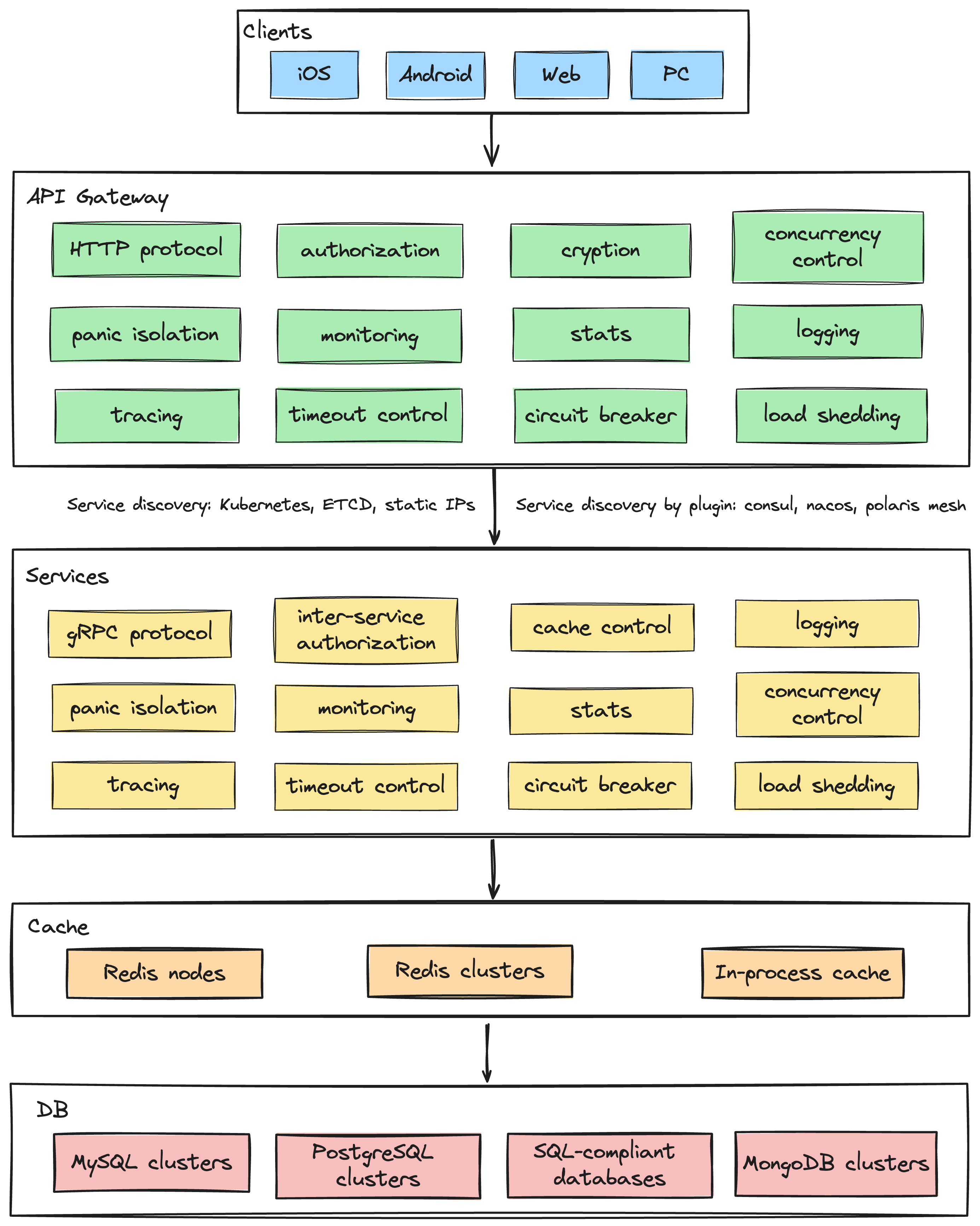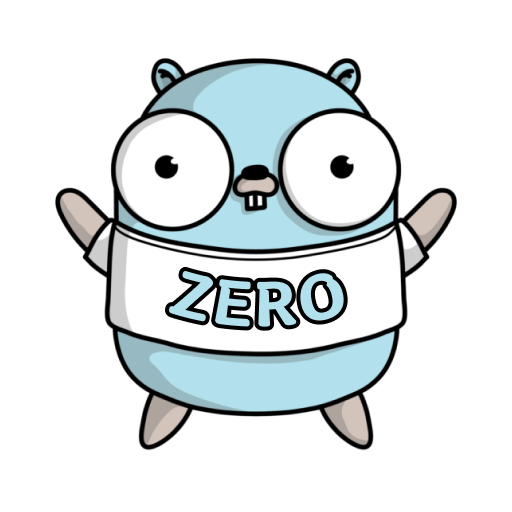readme.md 8.4 KB
go-zero
English | 简体中文
0. what is go-zero
go-zero is a web and rpc framework with lots of builtin engineering practices. It’s born to ensure the stability of the busy services with resilience design, and has been serving sites with tens of millions users for years.
go-zero contains simple API description syntax and code generation tool called goctl. You can generate Go, iOS, Android, Kotlin, Dart, TypeScript, JavaScript from .api files with goctl.
Advantages of go-zero:
- improve the stability of the services with tens of millions of daily active users
- builtin chained timeout control, concurrency control, rate limit, adaptive circuit breaker, adaptive load shedding, even no configuration needed
- builtin middlewares also can be integrated into your frameworks
- simple API syntax, one command to generate couple of different languages
- auto validate the request parameters from clients
- plenty of builtin microservice management and concurrent toolkits

1. Backgrounds of go-zero
At the beginning of 2018, we decided to re-design our system, from monolithic architecture with Java+MongoDB to microservice architecture. After researches and comparison, we chose to:
- Golang based
- great performance
- simple syntax
- proven engineering efficiency
- extreme deployment experience
- less server resource consumption
- Self-designed microservice architecture
- I have rich experience on designing microservice architectures
- easy to location the problems
- easy to extend the features
2. Design considerations on go-zero
By designing the microservice architecture, we expected to ensure the stability, as well as the productivity. And from just the beginning, we have the following design principles:
- keep it simple
- high availability
- stable on high concurrency
- easy to extend
- resilience design, failure-oriented programming
- try best to be friendly to the business logic development, encapsulate the complexity
- one thing, one way
After almost half a year, we finished the transfer from monolithic system to microservice system, and deployed on August 2018. The new system guaranteed the business growth, and the system stability.
3. The implementation and features of go-zero
go-zero is a web and rpc framework that integrates lots of engineering practices. The features are mainly listed below:
- powerful tool included, less code to write
- simple interfaces
- fully compatible with net/http
- middlewares are supported, easy to extend
- high performance
- failure-oriented programming, resilience design
- builtin service discovery, load balancing
- builtin concurrency control, adaptive circuit breaker, adaptive load shedding, auto trigger, auto recover
- auto validation of API request parameters
- chained timeout control
- auto management of data caching
- call tracing, metrics and monitoring
- high concurrency protected
As below, go-zero protects the system with couple layers and mechanisms:
4. Future development plans of go-zero
- auto generate API mock server, make the client debugging easier
- auto generate the simple integration test for the server side just from the .api files
5. Installation
Run the following command under your project:
go get -u git.i2edu.net/i2/go-zero
6. Quick Start
full examples can be checked out from below:
install goctl
goctlcan be read as go control. goctl means not to be controlled by code, instead, we control it. The inside go is not golang. At the very beginning, I was expecting it to help us improve the productivity, and make our lives easier.
GO111MODULE=on go get -u git.i2edu.net/i2/go-zero/tools/goctl
make sure goctl is executable.
- create the API file, like greet.api, you can install the plugin of goctl in vs code, api syntax is supported.
type Request struct {
Name string `path:"name,options=you|me"` // parameters are auto validated
}
type Response struct {
Message string `json:"message"`
}
service greet-api {
@handler GreetHandler
get /greet/from/:name(Request) returns (Response);
}
the .api files also can be generate by goctl, like below:
goctl api -o greet.api
- generate the go server side code
goctl api go -api greet.api -dir greet
the generated files look like:
├── greet
│ ├── etc
│ │ └── greet-api.yaml // configuration file
│ ├── greet.go // main file
│ └── internal
│ ├── config
│ │ └── config.go // configuration definition
│ ├── handler
│ │ ├── greethandler.go // get/put/post/delete routes are defined here
│ │ └── routes.go // routes list
│ ├── logic
│ │ └── greetlogic.go // request logic can be written here
│ ├── svc
│ │ └── servicecontext.go // service context, mysql/redis can be passed in here
│ └── types
│ └── types.go // request/response defined here
└── greet.api // api description file
the generated code can be run directly:
cd greet
go mod init
go mod tidy
go run greet.go -f etc/greet-api.yaml
by default, it’s listening on port 8888, while it can be changed in configuration file.
you can check it by curl:
curl -i http://localhost:8888/greet/from/you
the response looks like:
HTTP/1.1 200 OK
Date: Sun, 30 Aug 2020 15:32:35 GMT
Content-Length: 0
Write the business logic code
- the dependencies can be passed into the logic within servicecontext.go, like mysql, reds etc.
- add the logic code in logic package according to .api file
Generate code like Java, TypeScript, Dart, JavaScript etc. just from the api file
goctl api java -api greet.api -dir greet
goctl api dart -api greet.api -dir greet
...
7. Benchmark
8. Documents (adding)
- Documents
- Rapid development of microservice systems
- Rapid development of microservice systems - multiple RPCs
- Examples
9. Important notes
- Use grpc 1.29.1, because etcd lib doesn’t support latter versions.
google.golang.org/grpc v1.29.1
- For protobuf compatibility, use
protocol-gen@v1.3.2.
go get -u github.com/golang/protobuf/protoc-gen-go@v1.3.2
10. Chat group
Join the chat via https://join.slack.com/t/go-zero/shared_invite/zt-qxlclrv9-MWrCNkB2DpSgtEK2tVXJcw
Give a Star! ⭐
If you like or are using this project to learn or start your solution, please give it a star. Thanks!




